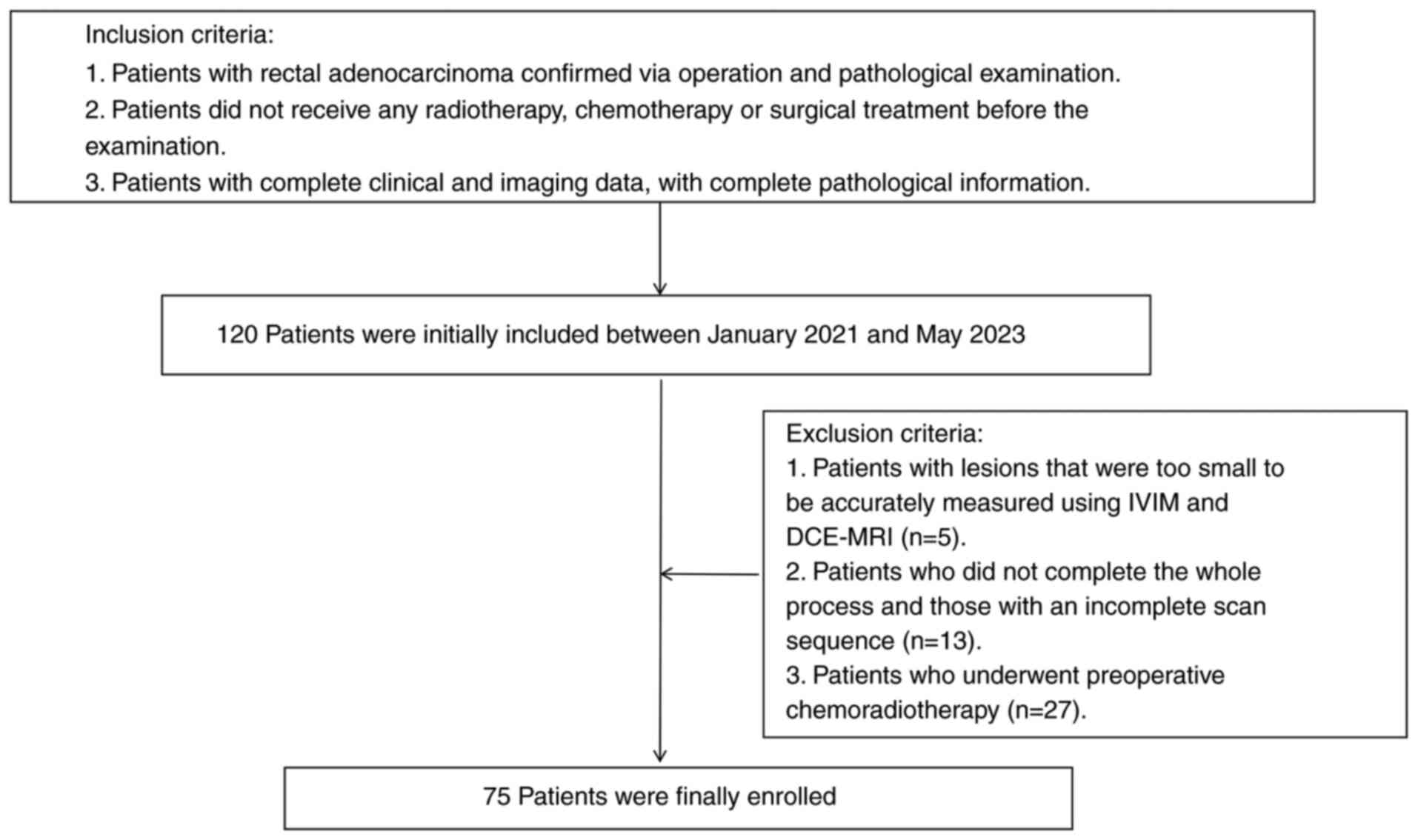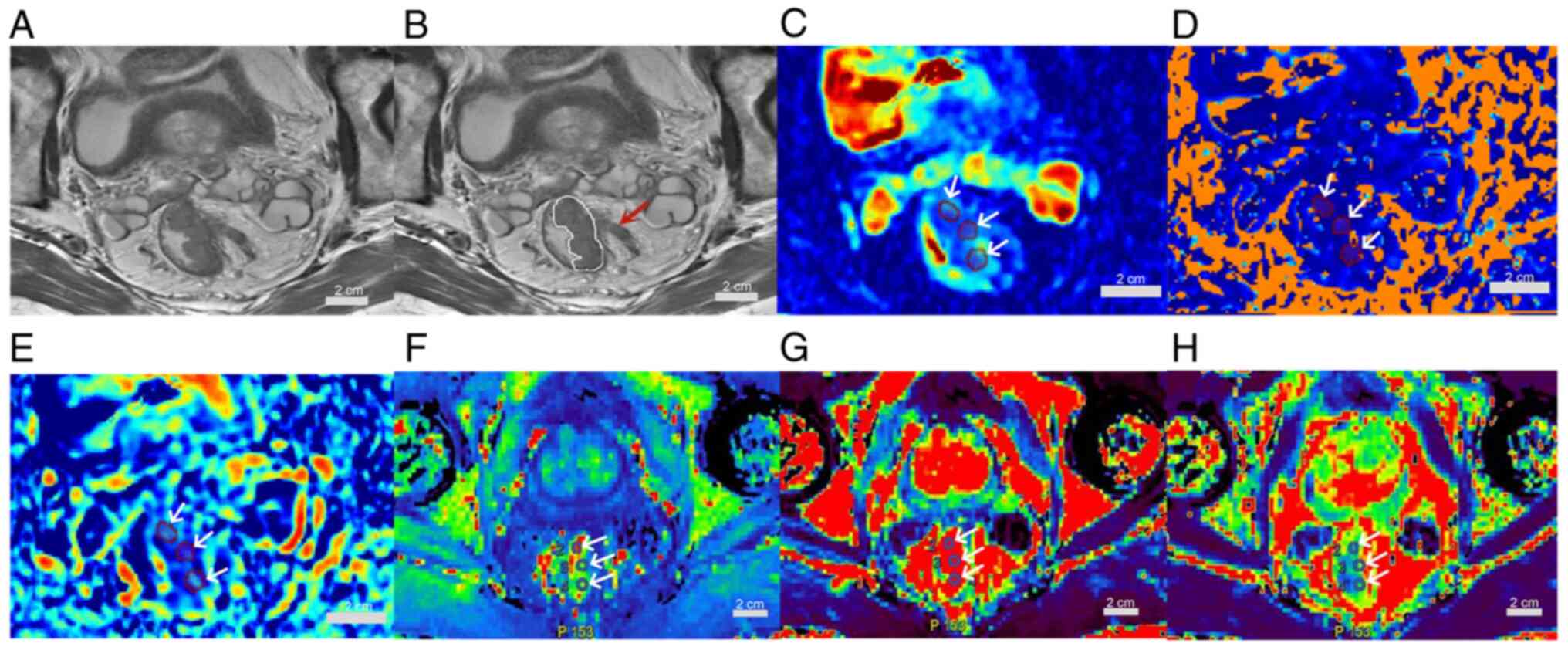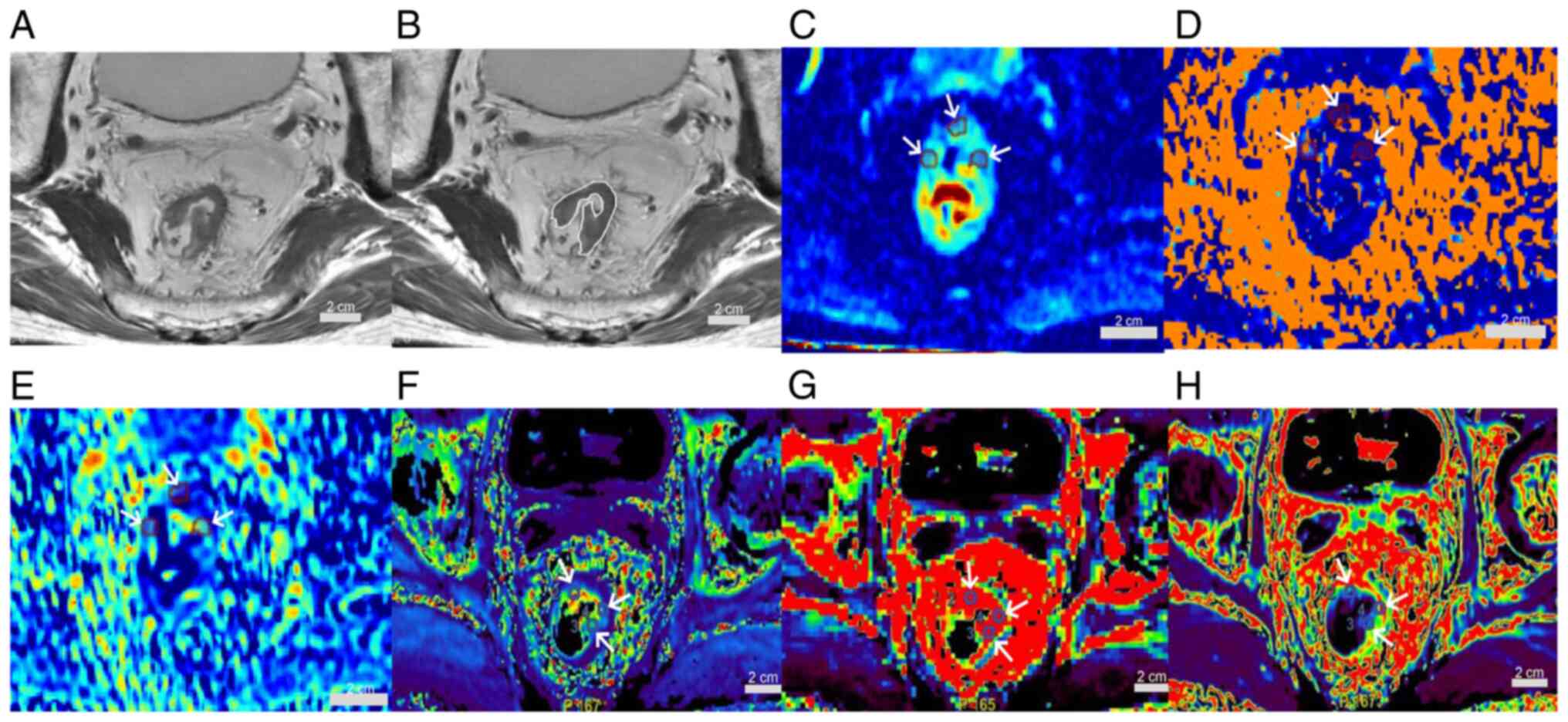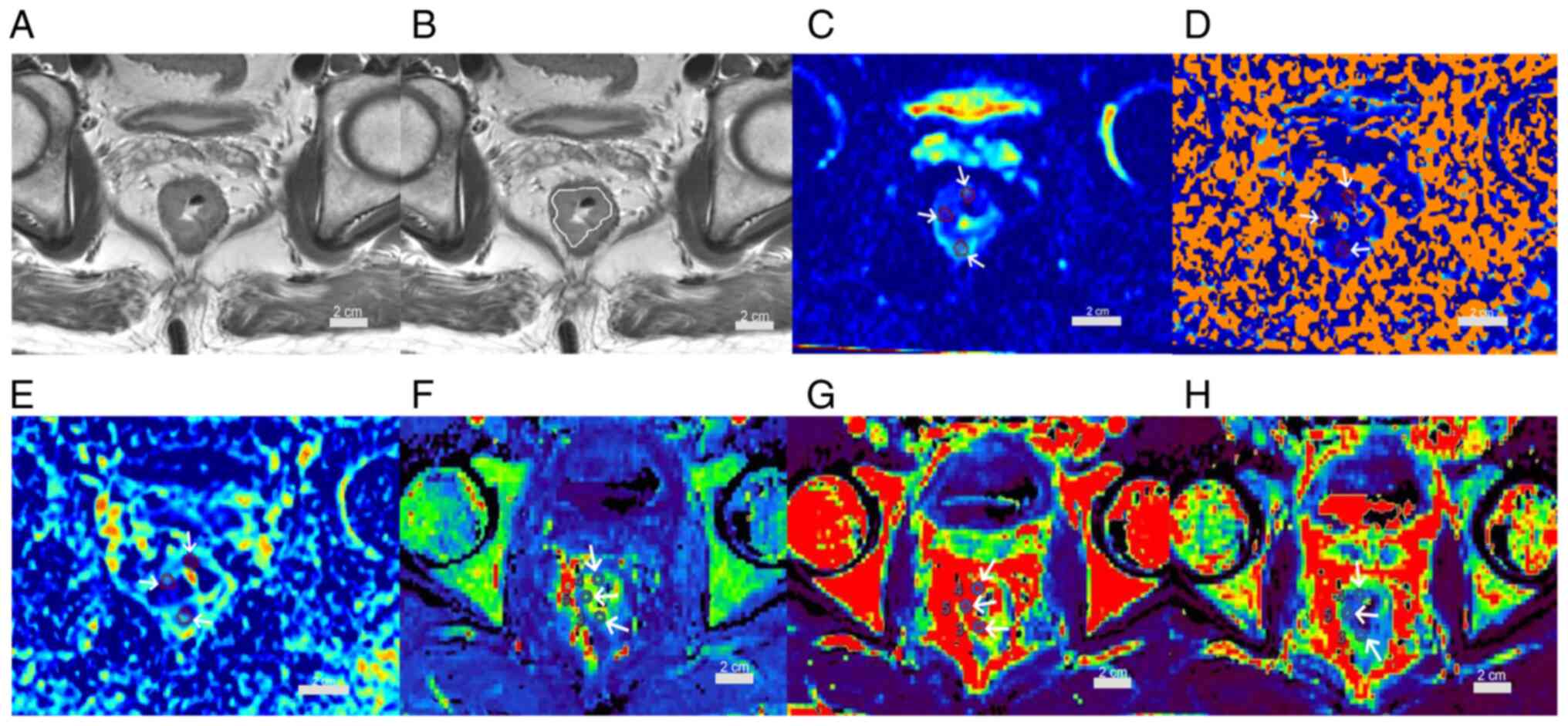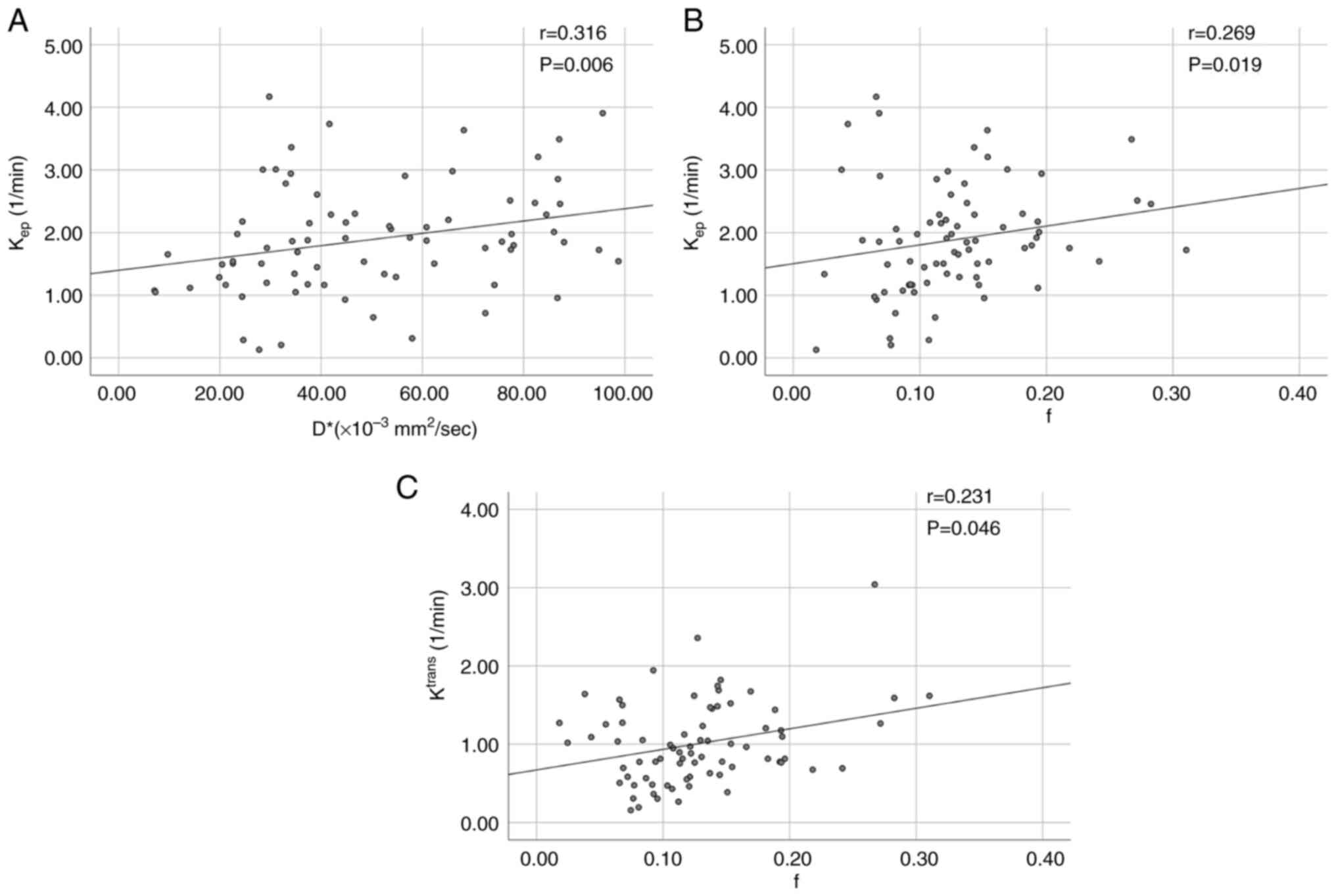|
1
|
Han B, Zheng R, Zeng H, Wang S, Sun K,
Chen R, Li L, Wei W and He J: Cancer incidence and mortality in
China, 2022. J Natl Cancer Cent. 4:47–53. 2024. View Article : Google Scholar : PubMed/NCBI
|
|
2
|
Glynne-Jones R, Wyrwicz L, Tiret E, Brown
G, Rödel C, Cervantes A and Arnold D; ESMO Guidelines Committee, :
Rectal cancer: ESMO clinical practice guidelines for diagnosis,
treatment and follow-up. Ann Oncol. 28:iv22–iv40. 2017. View Article : Google Scholar : PubMed/NCBI
|
|
3
|
Glynne-Jones R, Wyrwicz L, Tiret E, Brown
G, Rödel C, Cervantes A and Arnold D; ESMO Guidelines Committee, :
Rectal cancer: ESMO clinical practice guidelines for diagnosis,
treatment and follow-up. Ann Oncol. 29 (Suppl 4):iv2632018.
View Article : Google Scholar : PubMed/NCBI
|
|
4
|
Bates DDB, Homsi ME, Chang KJ, Lalwani N,
Horvat N and Sheedy SP: MRI for rectal cancer: Staging, mrCRM,
EMVI, lymph node staging and post-treatment response. Clin
Colorectal Cancer. 21:10–18. 2022. View Article : Google Scholar : PubMed/NCBI
|
|
5
|
Meyer HJ, Höhn AK, Woidacki K, Andric M,
Powerski M, Pech M and Surov A: Associations between IVIM histogram
parameters and histopathology in rectal cancer. Magn Reson Imaging.
77:21–27. 2021. View Article : Google Scholar : PubMed/NCBI
|
|
6
|
Nougaret S, Jhaveri K, Kassam Z, Lall C
and Kim DH: Rectal cancer MR staging: Pearls and pitfalls at
baseline examination. Abdom Radiol (NY). 44:3536–3548. 2019.
View Article : Google Scholar : PubMed/NCBI
|
|
7
|
Surov A, Meyer HJ, Höhn AK, Behrmann C,
Wienke A, Spielmann RP and Garnov N: Correlations between
intravoxel incoherent motion (IVIM) parameters and histological
findings in rectal cancer: Preliminary results. Oncotarget.
8:21974–2198. 2017. View Article : Google Scholar : PubMed/NCBI
|
|
8
|
Arian A, Taher HJ, Alareer HS and Aghili
M: Value of conventional MRI, DCE-MRI, and DWI-MRI in the
discrimination of metastatic from non-metastatic lymph nodes in
rectal cancer: A systematic review and meta-analysis study. Asian
Pac J Cancer Prev. 24:401–410. 2023. View Article : Google Scholar : PubMed/NCBI
|
|
9
|
Reynolds HM, Parameswaran BK, Finnegan ME,
Roettger D, Lau E, Kron T, Shaw M, Chander S and Siva S: Diffusion
weighted and dynamic contrast enhanced mri as an imaging biomarker
for stereotactic ablative body radiotherapy (Sabr) of primary renal
cell carcinoma. PLoS One. 13:e02023872018. View Article : Google Scholar : PubMed/NCBI
|
|
10
|
Jia H, Jiang X, Zhang K, Shang J, Zhang Y,
Fang X, Gao F, Li N and Dong J: A nomogram of combining IVIM-DWI
and MRI radiomics from the primary lesion of rectal adenocarcinoma
to assess nonenlarged lymph node metastasis preoperatively. J Magn
Reson Imaging. 56:658–667. 2022. View Article : Google Scholar : PubMed/NCBI
|
|
11
|
Yuan J, Gong Z, Liu K, Song J, Wen Q, Tan
W, Zhan S and Shen Q: Correlation between diffusion kurtosis and
intravoxel incoherent motion derived (IVIM) parameters and tumor
tissue composition in rectal cancer: A pilot study. Abdom Radiol
(NY). 47:1223–1231. 2022. View Article : Google Scholar : PubMed/NCBI
|
|
12
|
Liu B, Sun C, Zhao X, Liu L, Liu S and Ma
H: The value of multimodality MR in T staging evaluation after
neoadjuvant therapy for rectal cancer. Technol Health Care.
32:615–627. 2024. View Article : Google Scholar : PubMed/NCBI
|
|
13
|
Wang KX, Yu J and Xu Q: Histogram analysis
of dynamic contrast-enhanced magnetic resonance imaging to predict
extramural venous invasion in rectal cancer. BMC Med Imaging.
23:772023. View Article : Google Scholar : PubMed/NCBI
|
|
14
|
Geng Z, Zhang Y, Yin S, Lian S, He H, Li
H, Xie C and Dai Y: Preoperatively grading rectal cancer with the
combination of intravoxel incoherent motions imaging and diffusion
kurtosis imaging. Contrast Media Mol Imaging. 2020:21645092020.
View Article : Google Scholar : PubMed/NCBI
|
|
15
|
Hu H, Jiang H, Wang S, Jiang H, Zhao S and
Pan W: 3.0 T MRI IVIM-DWI for predicting the efficacy of
neoadjuvant chemoradiation for locally advanced rectal cancer.
Abdom Radiol (NY). 46:134–143. 2021. View Article : Google Scholar : PubMed/NCBI
|
|
16
|
Bogveradze N, El Khababi N, Schurink NW,
van Griethuysen JJM, de Bie S, Bosma G, Cappendijk VC, Geenen RWF,
Neijenhuis P, Peterson G, et al: Evolutions in rectal cancer MRI
staging and risk stratification in The Netherlands. Abdom Radiol
(NY). 47:38–47. 2022. View Article : Google Scholar : PubMed/NCBI
|
|
17
|
Zhao M, Feng L, Zhao K, Cui Y, Li Z, Ke C,
Yang X, Qiu Q, Lu W, Liang Y, et al: An MRI-based scoring system
for pretreatment risk stratification in locally advanced rectal
cancer. Br J Cancer. 129:1095–1104. 2023. View Article : Google Scholar : PubMed/NCBI
|
|
18
|
Mao L, Li Y, Cui B, Lu L, Dou W, Pylypenko
D, Zhu J and Li H: Multiparametric MRI for staging of bowel
inflammatory activity in Crohn's disease with MUSE-IVIM and
DCE-MRI: A preliminary study. Acad Radiol. 31:880–888. 2024.
View Article : Google Scholar : PubMed/NCBI
|
|
19
|
Tao J, Yin Z, Li X, Zhang Y, Zhang K, Yang
Y, Fang S and Wang S: Correlation between IVIM parameters and
microvessel architecture: Direct comparison of MRI images and
pathological slices in an orthotopic murine model of
rhabdomyosarcoma. Eur Radiol. 33:8576–8584. 2023. View Article : Google Scholar : PubMed/NCBI
|
|
20
|
Arian A, Seyed-Kolbadi FZ, Yaghoobpoor S,
Ghorani H, Saghazadeh A and Ghadimi DJ: Diagnostic accuracy of
intravoxel incoherent motion (IVIM) and dynamic contrast-enhanced
(DCE) MRI to differentiate benign from malignant breast lesions: A
systematic review and meta-analysis. Eur J Radiol. 167:1110512023.
View Article : Google Scholar : PubMed/NCBI
|
|
21
|
Le Bihan D, Breton E, Lallemand D, Aubin
ML, Vignaud J and Laval-Jeantet M: Separation of diffusion and
perfusion in intravoxel incoherent motion MR imaging. Radiology.
168:497–505. 1988. View Article : Google Scholar : PubMed/NCBI
|
|
22
|
Li J, Gao X, Nickel MD, Cheng J and Zhu J:
Native T1 mapping for differentiating the histopathologic type,
grade, and stage of rectal adenocarcinoma: A pilot study. Cancer
Imaging. 22:302022. View Article : Google Scholar : PubMed/NCBI
|
|
23
|
Washington MK, Berlin J, Branton P,
Burgart LJ, Carter DK, Fitzgibbons PL, Halling K, Frankel W, Jessup
J, Kakar S, et al: Protocol for the examination of specimens from
patients with primary carcinoma of the colon and rectum. Arch
Pathol Lab Med. 133:1539–1551. 2009. View Article : Google Scholar : PubMed/NCBI
|
|
24
|
Li X, Huang W and Holmes JH: Dynamic
contrast-enhanced (DCE) MRI. Magn Reson Imaging Clin N Am.
32:47–61. 2024. View Article : Google Scholar : PubMed/NCBI
|
|
25
|
Horvat N, Rocha CC, Oliveira BC, Petkovska
I and Gollub MJ: MRI of rectal cancer: Tumor staging, imaging
techniques, and management. Radiographics. 39:367–387. 2019.
View Article : Google Scholar : PubMed/NCBI
|
|
26
|
Bonekamp D and Macura KJ: Dynamic
contrast-enhanced magnetic resonance imaging in the evaluation of
the prostate. Top Magn Reson Imaging. 19:273–84. 2008. View Article : Google Scholar : PubMed/NCBI
|
|
27
|
Chen Y, Yang X, Wen Z, Liu Y, Lu B, Yu S
and Xiao X: Association between high-resolution MRI-detected
extramural vascular invasion and tumour microcirculation estimated
by dynamic contrast-enhanced MRI in rectal cancer: Preliminary
results. BMC Cancer. 19:4982019. View Article : Google Scholar : PubMed/NCBI
|
|
28
|
Kim YE, Lim JS, Choi J, Kim D, Myoung S,
Kim MJ and Kim KW: Perfusion parameters of dynamic
contrast-enhanced magnetic resonance imaging in patients with
rectal cancer: Correlation with microvascular density and vascular
endothelial growth factor expression. Korean J Radiol. 14:878–885.
2013. View Article : Google Scholar : PubMed/NCBI
|
|
29
|
Wang H, Yan R, Li Z, Wang B, Jin X, Guo Z,
Liu W, Zhang M, Wang K, Guo J and Han D: Quantitative dynamic
contrast-enhanced parameters and intravoxel incoherent motion
facilitate the prediction of TP53 status and risk stratification of
early-stage endometrial carcinoma. Radiol Oncol. 57:257–269. 2023.
View Article : Google Scholar : PubMed/NCBI
|
|
30
|
Sun D, Wu X, Wang L, Li G, Huang J and Li
Y: Distinguishing T1-2 and T3a tumors of rectal cancer with texture
analysis and functional MRI parameters. Diagn Interv Radiol.
28:200–207. 2022. View Article : Google Scholar : PubMed/NCBI
|
|
31
|
Ao W, Zhang X, Yao X, Zhu X, Deng S and
Feng J: Preoperative prediction of extramural venous invasion in
rectal cancer by dynamic contrast-enhanced and diffusion weighted
MRI: A preliminary study. BMC Med Imaging. 22:1–12. 2022.
View Article : Google Scholar : PubMed/NCBI
|
|
32
|
Cho N, Im SA, Park IA, Lee KH, Li M, Han
W, Noh DY and Moon WK: Breast cancer: Early prediction of response
to neoadjuvant chemotherapy using parametric response maps for MR
imaging. Radiology. 272:385–396. 2014. View Article : Google Scholar : PubMed/NCBI
|
|
33
|
Moreno CC, Sullivan PS, Kalb BT, Tipton
RG, Hanley KZ, Kitajima HD, Dixon WT, Votaw JR, Oshinski JN and
Mittal PK: Magnetic resonance imaging of rectal cancer: Staging and
restaging evaluation. Abdom Imaging. 40:2613–2629. 2015. View Article : Google Scholar : PubMed/NCBI
|
|
34
|
Lord AC, D'Souza N, Shaw A, Rokan Z, Moran
B, Abulafi M, Rasheed S, Chandramohan A, Corr A, Chau I and Brown
G: MRI-diagnosed tumor deposits and EMVI status have superior
prognostic accuracy to current clinical TNM staging in rectal
cancer. Ann Surg. 276:334–344. 2022. View Article : Google Scholar : PubMed/NCBI
|
|
35
|
Shin J, Seo N, Baek SE, Son NH, Lim JS,
Kim NK, Koom WS and Kim S: MRI radiomics model predicts pathologic
complete response of rectal cancer following chemoradiotherapy.
Radiology. 303:351–358. 2022. View Article : Google Scholar : PubMed/NCBI
|
|
36
|
Fernandes MC, Gollub MJ and Brown G: The
importance of MRI for rectal cancer evaluation. Surg Oncol.
43:1017392022. View Article : Google Scholar : PubMed/NCBI
|
|
37
|
Liu B, Zeng Q, Huang J, Zhang J, Zheng Z,
Liao Y, Deng K, Zhou W and Xu Y: IVIM using convolutional neural
networks predicts microvascular invasion in HCC. Eur Radiol.
32:7185–7195. 2022. View Article : Google Scholar : PubMed/NCBI
|
|
38
|
Zhao L, Liang M, Yang Y, Zhao X and Zhang
H: Histogram models based on intravoxel incoherent motion
diffusion-weighted imaging to predict nodal staging of rectal
cancer. Eur J Radiol. 142:1098692021. View Article : Google Scholar : PubMed/NCBI
|
|
39
|
Liu L, Zhou G, Rao S and Zeng M: Early
changes in intravoxel incoherent motion MRI parameters can
potentially predict response to chemoradiotherapy in rectal cancer:
An animal study. Magn Reson Imaging. 78:52–57. 2021. View Article : Google Scholar : PubMed/NCBI
|
|
40
|
Li J, Lin L, Gao X, Li S and Cheng J:
Amide proton transfer weighted and intravoxel incoherent motion
imaging in evaluation of prognostic factors for rectal
adenocarcinoma. Front Oncol. 11:7835442022. View Article : Google Scholar : PubMed/NCBI
|
|
41
|
Chang CB, Lin YC, Wong YC, Lin SN, Lin CY,
Lin YH, Sheng TW, Huang CC, Yang LY and Wang LJ: IVIM parameters on
MRI could predict ISUP risk groups of prostate cancers on radical
prostatectomy. Front Oncol. 11:6590142021. View Article : Google Scholar : PubMed/NCBI
|
|
42
|
Iima M: Perfusion-driven intravoxel
incoherent motion (IVIM) MRI in oncology: Applications, challenges
future trends. Magn Reson Med Sci. 20:125–138. 2021. View Article : Google Scholar : PubMed/NCBI
|
|
43
|
Meng N, Fang T, Feng P, Huang Z, Sun J,
Wang X, Shang J, Wang K, Han D and Wang M: Amide proton
transfer-weighted imaging and multiple models diffusion-weighted
imaging facilitates preoperative risk stratification of early-stage
endometrial carcinoma. J Magn Reson Imaging. 54:1200–1211. 2021.
View Article : Google Scholar : PubMed/NCBI
|
|
44
|
Kikuchi K, Hiwatashi A, Togao O, Yamashita
K, Kamei R, Momosaka D, Hata N, Iihara K, Suzuki SO, Iwaki T and
Honda H: Intravoxel incoherent motion MR imaging of pediatric
intracranial tumors: Correlation with histology and diagnostic
utility. AJNR Am J Neuroradiol. 40:878–884. 2019. View Article : Google Scholar : PubMed/NCBI
|
|
45
|
Yang D, She H, Wang X, Yang Z and Wang Z:
Diagnostic accuracy of quantitative diffusion parameters in the
pathological grading of hepatocellular carcinoma: A meta-analysis.
J Magn Reson Imaging. 51:1581–1593. 2020. View Article : Google Scholar : PubMed/NCBI
|
|
46
|
Dolciami M, Capuani S, Celli V, Maiuro A,
Pernazza A, Palaia I, Di Donato V, Santangelo G, Rizzo SMR, Ricci
P, et al: Intravoxel incoherent motion (IVIM) MR quantification in
locally advanced cervical cancer (LACC): Preliminary study on
assessment of tumor aggressiveness and response to neoadjuvant
chemotherapy. J Pers Med. 12:6382022. View Article : Google Scholar : PubMed/NCBI
|
|
47
|
Kooreman ES, van Pelt V, Nowee ME, Pos F,
van der Heide UA and van Houdt PJ: Longitudinal correlations
between intravoxel incoherent motion (IVIM) and dynamic
contrast-enhanced (DCE) MRI during radiotherapy in prostate cancer
patients. Front Oncol. 12:8971302022. View Article : Google Scholar : PubMed/NCBI
|
|
48
|
Ye Z, Ning G, Li X, Koh TS, Chen H, Bai W
and Qu H: Endometrial carcinoma: Use of tracer kinetic modeling of
dynamic contrast-enhanced MRI for preoperative risk assessment.
Cancer Imaging. 22:142022. View Article : Google Scholar : PubMed/NCBI
|
|
49
|
Chen Y, Li B, Jiang Z, Li H, Dang Y, Tang
C, Xia Y, Zhang H, Song B and Long L: Multi-parameter diffusion and
perfusion magnetic resonance imaging and radiomics nomogram for
preoperative evaluation of aquaporin-1 expression in rectal cancer.
Abdom Radiol (NY). 47:1276–1290. 2022. View Article : Google Scholar : PubMed/NCBI
|



